Management Accounting Report: Costing Techniques Analysis
VerifiedAdded on 2020/10/22
|15
|4942
|486
Report
AI Summary
This report provides a comprehensive analysis of management accounting, focusing on its application within a small company, Aston Chemicals. It explores various management accounting systems, including cost accounting, price optimization, inventory management, and job costing, detailing their benefits and applications. The report further examines different management accounting reporting methods like performance reporting, inventory management reporting, job cost reporting, and account receivable reporting. It also includes calculations of costs using marginal and absorption costing techniques. Moreover, the report addresses financial problems faced by businesses and discusses planning tools and techniques for budgetary control, concluding with how management accounting contributes to sustainable success in resolving financial issues. The report provides a detailed overview of management accounting principles, techniques, and their practical application within a business context.
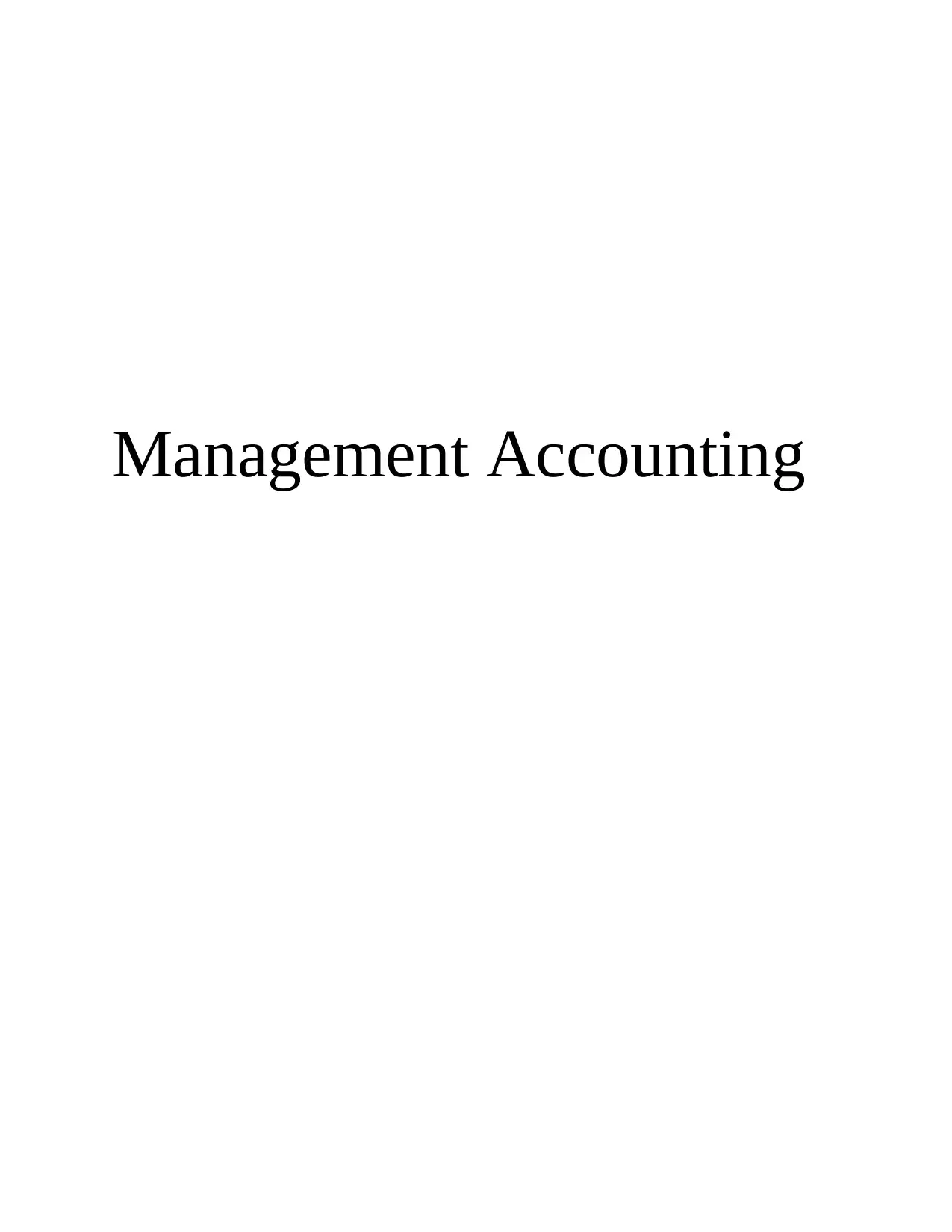
Management Accounting
Paraphrase This Document
Need a fresh take? Get an instant paraphrase of this document with our AI Paraphraser
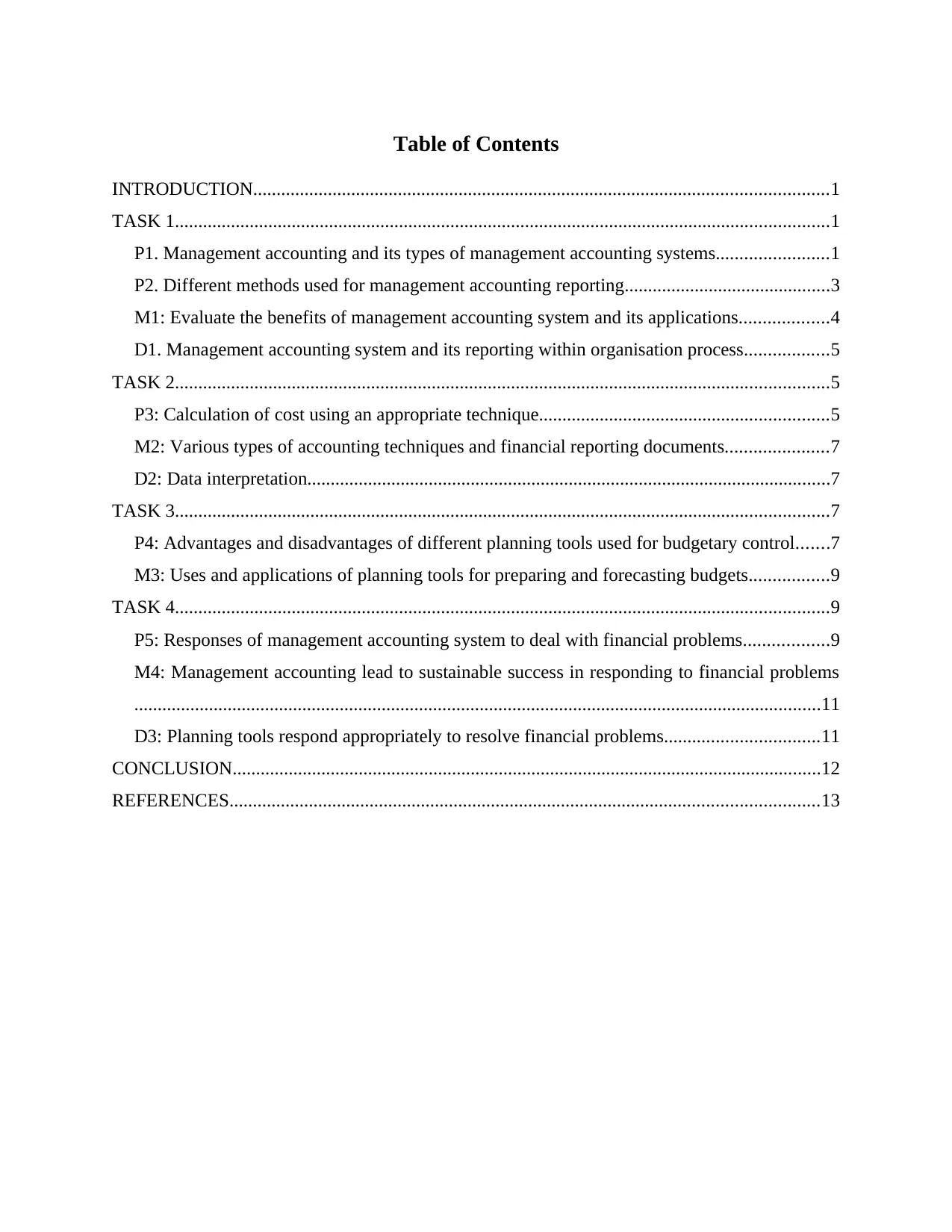
Table of Contents
INTRODUCTION...........................................................................................................................1
TASK 1............................................................................................................................................1
P1. Management accounting and its types of management accounting systems........................1
P2. Different methods used for management accounting reporting............................................3
M1: Evaluate the benefits of management accounting system and its applications...................4
D1. Management accounting system and its reporting within organisation process..................5
TASK 2............................................................................................................................................5
P3: Calculation of cost using an appropriate technique..............................................................5
M2: Various types of accounting techniques and financial reporting documents......................7
D2: Data interpretation................................................................................................................7
TASK 3............................................................................................................................................7
P4: Advantages and disadvantages of different planning tools used for budgetary control.......7
M3: Uses and applications of planning tools for preparing and forecasting budgets.................9
TASK 4............................................................................................................................................9
P5: Responses of management accounting system to deal with financial problems..................9
M4: Management accounting lead to sustainable success in responding to financial problems
...................................................................................................................................................11
D3: Planning tools respond appropriately to resolve financial problems.................................11
CONCLUSION..............................................................................................................................12
REFERENCES..............................................................................................................................13
INTRODUCTION...........................................................................................................................1
TASK 1............................................................................................................................................1
P1. Management accounting and its types of management accounting systems........................1
P2. Different methods used for management accounting reporting............................................3
M1: Evaluate the benefits of management accounting system and its applications...................4
D1. Management accounting system and its reporting within organisation process..................5
TASK 2............................................................................................................................................5
P3: Calculation of cost using an appropriate technique..............................................................5
M2: Various types of accounting techniques and financial reporting documents......................7
D2: Data interpretation................................................................................................................7
TASK 3............................................................................................................................................7
P4: Advantages and disadvantages of different planning tools used for budgetary control.......7
M3: Uses and applications of planning tools for preparing and forecasting budgets.................9
TASK 4............................................................................................................................................9
P5: Responses of management accounting system to deal with financial problems..................9
M4: Management accounting lead to sustainable success in responding to financial problems
...................................................................................................................................................11
D3: Planning tools respond appropriately to resolve financial problems.................................11
CONCLUSION..............................................................................................................................12
REFERENCES..............................................................................................................................13
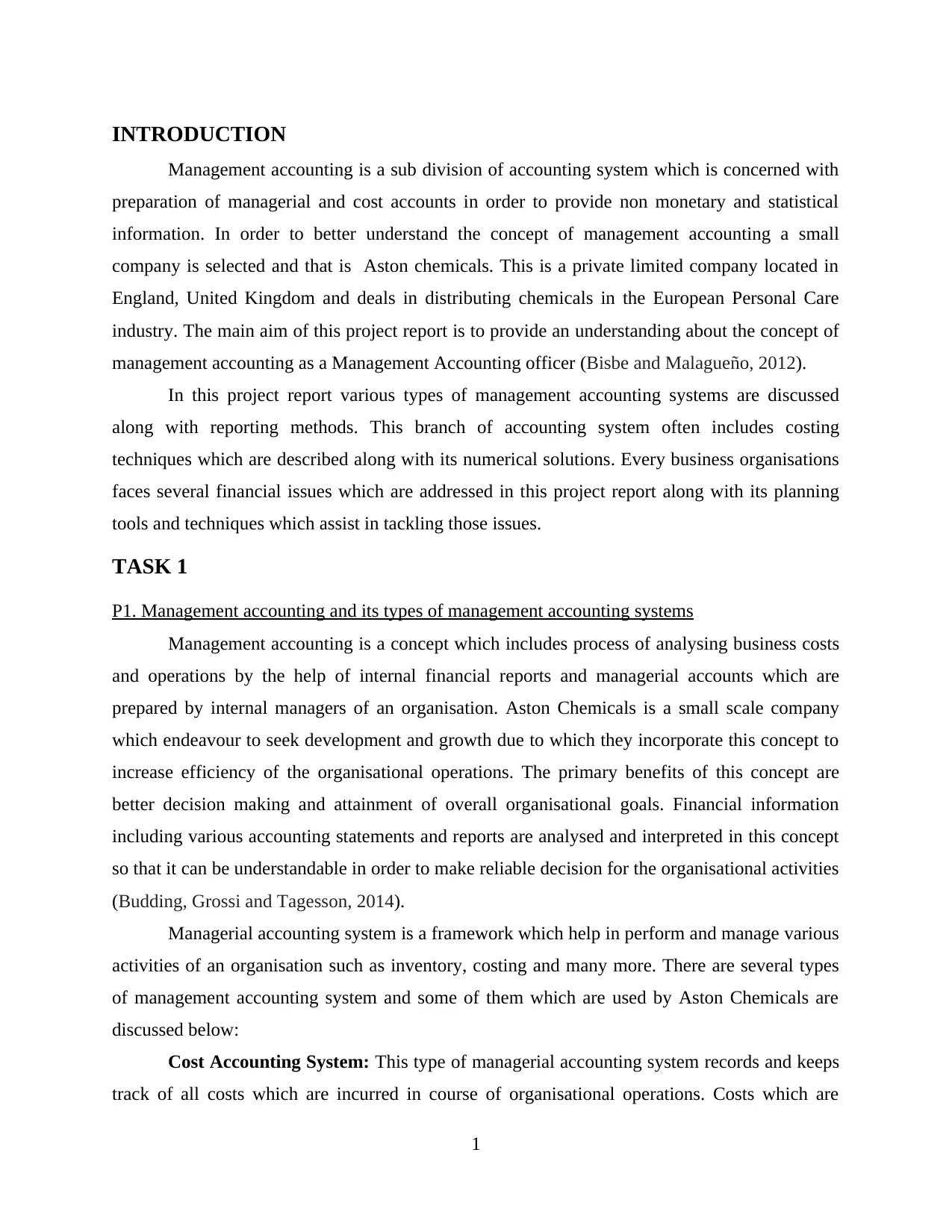
INTRODUCTION
Management accounting is a sub division of accounting system which is concerned with
preparation of managerial and cost accounts in order to provide non monetary and statistical
information. In order to better understand the concept of management accounting a small
company is selected and that is Aston chemicals. This is a private limited company located in
England, United Kingdom and deals in distributing chemicals in the European Personal Care
industry. The main aim of this project report is to provide an understanding about the concept of
management accounting as a Management Accounting officer (Bisbe and Malagueño, 2012).
In this project report various types of management accounting systems are discussed
along with reporting methods. This branch of accounting system often includes costing
techniques which are described along with its numerical solutions. Every business organisations
faces several financial issues which are addressed in this project report along with its planning
tools and techniques which assist in tackling those issues.
TASK 1
P1. Management accounting and its types of management accounting systems
Management accounting is a concept which includes process of analysing business costs
and operations by the help of internal financial reports and managerial accounts which are
prepared by internal managers of an organisation. Aston Chemicals is a small scale company
which endeavour to seek development and growth due to which they incorporate this concept to
increase efficiency of the organisational operations. The primary benefits of this concept are
better decision making and attainment of overall organisational goals. Financial information
including various accounting statements and reports are analysed and interpreted in this concept
so that it can be understandable in order to make reliable decision for the organisational activities
(Budding, Grossi and Tagesson, 2014).
Managerial accounting system is a framework which help in perform and manage various
activities of an organisation such as inventory, costing and many more. There are several types
of management accounting system and some of them which are used by Aston Chemicals are
discussed below:
Cost Accounting System: This type of managerial accounting system records and keeps
track of all costs which are incurred in course of organisational operations. Costs which are
1
Management accounting is a sub division of accounting system which is concerned with
preparation of managerial and cost accounts in order to provide non monetary and statistical
information. In order to better understand the concept of management accounting a small
company is selected and that is Aston chemicals. This is a private limited company located in
England, United Kingdom and deals in distributing chemicals in the European Personal Care
industry. The main aim of this project report is to provide an understanding about the concept of
management accounting as a Management Accounting officer (Bisbe and Malagueño, 2012).
In this project report various types of management accounting systems are discussed
along with reporting methods. This branch of accounting system often includes costing
techniques which are described along with its numerical solutions. Every business organisations
faces several financial issues which are addressed in this project report along with its planning
tools and techniques which assist in tackling those issues.
TASK 1
P1. Management accounting and its types of management accounting systems
Management accounting is a concept which includes process of analysing business costs
and operations by the help of internal financial reports and managerial accounts which are
prepared by internal managers of an organisation. Aston Chemicals is a small scale company
which endeavour to seek development and growth due to which they incorporate this concept to
increase efficiency of the organisational operations. The primary benefits of this concept are
better decision making and attainment of overall organisational goals. Financial information
including various accounting statements and reports are analysed and interpreted in this concept
so that it can be understandable in order to make reliable decision for the organisational activities
(Budding, Grossi and Tagesson, 2014).
Managerial accounting system is a framework which help in perform and manage various
activities of an organisation such as inventory, costing and many more. There are several types
of management accounting system and some of them which are used by Aston Chemicals are
discussed below:
Cost Accounting System: This type of managerial accounting system records and keeps
track of all costs which are incurred in course of organisational operations. Costs which are
1
⊘ This is a preview!⊘
Do you want full access?
Subscribe today to unlock all pages.

Trusted by 1+ million students worldwide
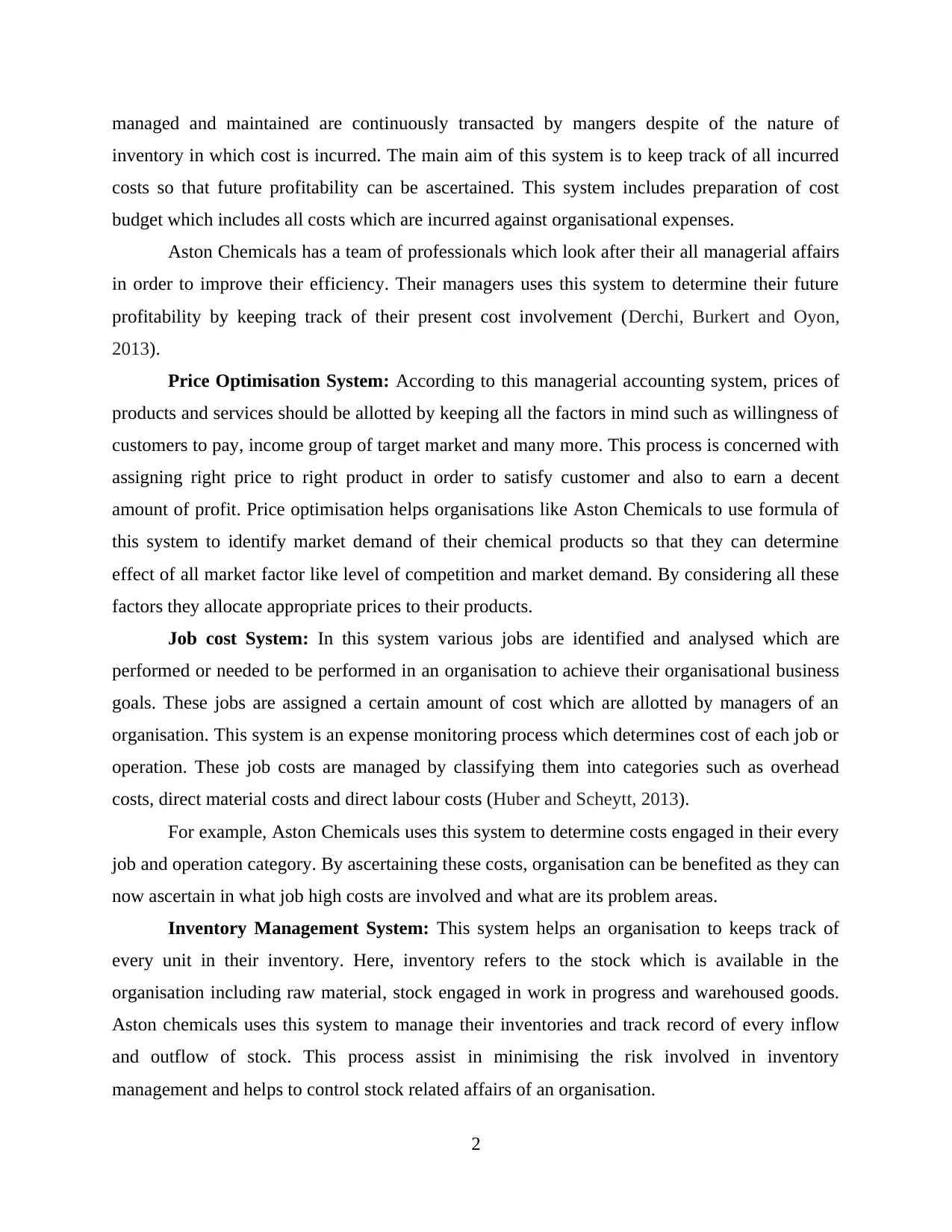
managed and maintained are continuously transacted by mangers despite of the nature of
inventory in which cost is incurred. The main aim of this system is to keep track of all incurred
costs so that future profitability can be ascertained. This system includes preparation of cost
budget which includes all costs which are incurred against organisational expenses.
Aston Chemicals has a team of professionals which look after their all managerial affairs
in order to improve their efficiency. Their managers uses this system to determine their future
profitability by keeping track of their present cost involvement (Derchi, Burkert and Oyon,
2013).
Price Optimisation System: According to this managerial accounting system, prices of
products and services should be allotted by keeping all the factors in mind such as willingness of
customers to pay, income group of target market and many more. This process is concerned with
assigning right price to right product in order to satisfy customer and also to earn a decent
amount of profit. Price optimisation helps organisations like Aston Chemicals to use formula of
this system to identify market demand of their chemical products so that they can determine
effect of all market factor like level of competition and market demand. By considering all these
factors they allocate appropriate prices to their products.
Job cost System: In this system various jobs are identified and analysed which are
performed or needed to be performed in an organisation to achieve their organisational business
goals. These jobs are assigned a certain amount of cost which are allotted by managers of an
organisation. This system is an expense monitoring process which determines cost of each job or
operation. These job costs are managed by classifying them into categories such as overhead
costs, direct material costs and direct labour costs (Huber and Scheytt, 2013).
For example, Aston Chemicals uses this system to determine costs engaged in their every
job and operation category. By ascertaining these costs, organisation can be benefited as they can
now ascertain in what job high costs are involved and what are its problem areas.
Inventory Management System: This system helps an organisation to keeps track of
every unit in their inventory. Here, inventory refers to the stock which is available in the
organisation including raw material, stock engaged in work in progress and warehoused goods.
Aston chemicals uses this system to manage their inventories and track record of every inflow
and outflow of stock. This process assist in minimising the risk involved in inventory
management and helps to control stock related affairs of an organisation.
2
inventory in which cost is incurred. The main aim of this system is to keep track of all incurred
costs so that future profitability can be ascertained. This system includes preparation of cost
budget which includes all costs which are incurred against organisational expenses.
Aston Chemicals has a team of professionals which look after their all managerial affairs
in order to improve their efficiency. Their managers uses this system to determine their future
profitability by keeping track of their present cost involvement (Derchi, Burkert and Oyon,
2013).
Price Optimisation System: According to this managerial accounting system, prices of
products and services should be allotted by keeping all the factors in mind such as willingness of
customers to pay, income group of target market and many more. This process is concerned with
assigning right price to right product in order to satisfy customer and also to earn a decent
amount of profit. Price optimisation helps organisations like Aston Chemicals to use formula of
this system to identify market demand of their chemical products so that they can determine
effect of all market factor like level of competition and market demand. By considering all these
factors they allocate appropriate prices to their products.
Job cost System: In this system various jobs are identified and analysed which are
performed or needed to be performed in an organisation to achieve their organisational business
goals. These jobs are assigned a certain amount of cost which are allotted by managers of an
organisation. This system is an expense monitoring process which determines cost of each job or
operation. These job costs are managed by classifying them into categories such as overhead
costs, direct material costs and direct labour costs (Huber and Scheytt, 2013).
For example, Aston Chemicals uses this system to determine costs engaged in their every
job and operation category. By ascertaining these costs, organisation can be benefited as they can
now ascertain in what job high costs are involved and what are its problem areas.
Inventory Management System: This system helps an organisation to keeps track of
every unit in their inventory. Here, inventory refers to the stock which is available in the
organisation including raw material, stock engaged in work in progress and warehoused goods.
Aston chemicals uses this system to manage their inventories and track record of every inflow
and outflow of stock. This process assist in minimising the risk involved in inventory
management and helps to control stock related affairs of an organisation.
2
Paraphrase This Document
Need a fresh take? Get an instant paraphrase of this document with our AI Paraphraser
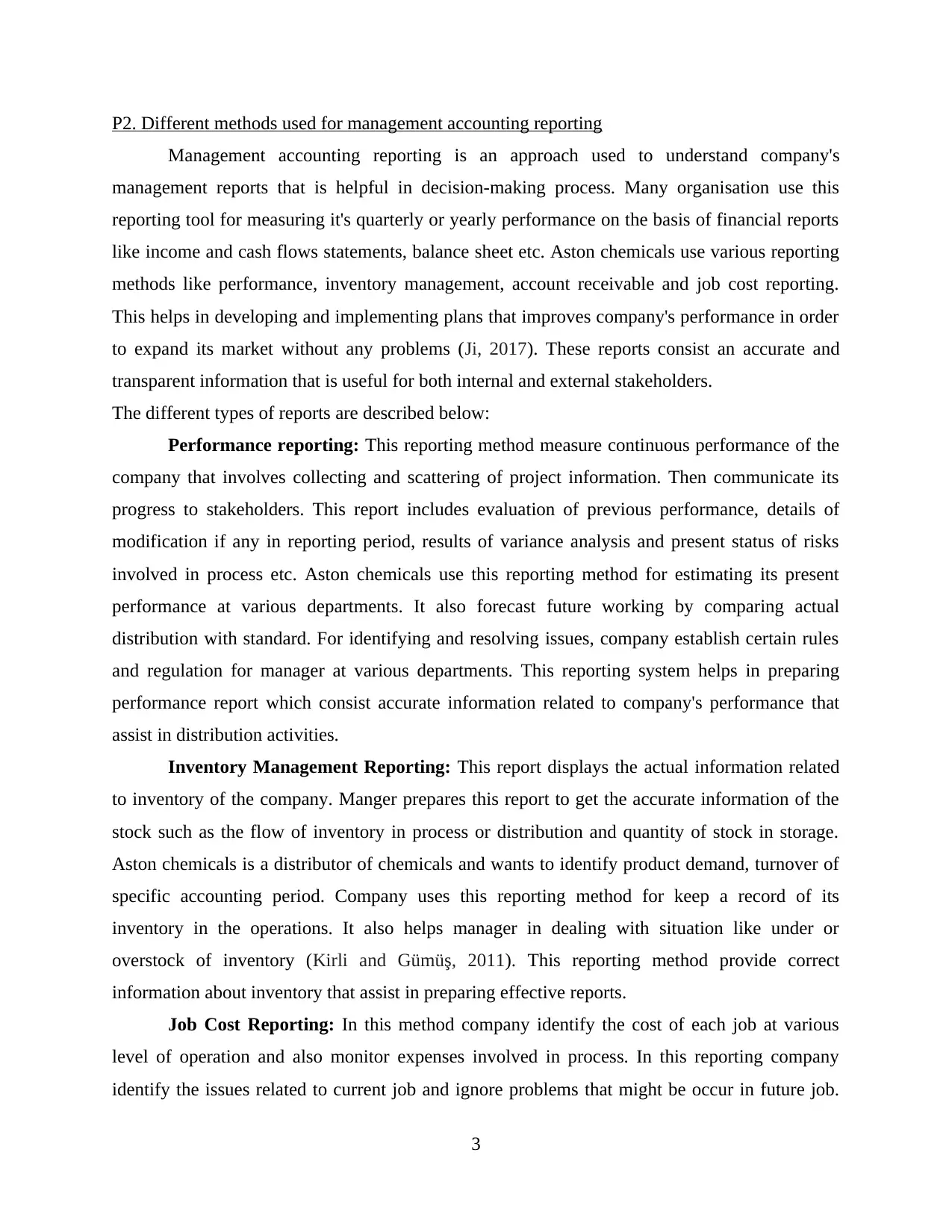
P2. Different methods used for management accounting reporting
Management accounting reporting is an approach used to understand company's
management reports that is helpful in decision-making process. Many organisation use this
reporting tool for measuring it's quarterly or yearly performance on the basis of financial reports
like income and cash flows statements, balance sheet etc. Aston chemicals use various reporting
methods like performance, inventory management, account receivable and job cost reporting.
This helps in developing and implementing plans that improves company's performance in order
to expand its market without any problems (Ji, 2017). These reports consist an accurate and
transparent information that is useful for both internal and external stakeholders.
The different types of reports are described below:
Performance reporting: This reporting method measure continuous performance of the
company that involves collecting and scattering of project information. Then communicate its
progress to stakeholders. This report includes evaluation of previous performance, details of
modification if any in reporting period, results of variance analysis and present status of risks
involved in process etc. Aston chemicals use this reporting method for estimating its present
performance at various departments. It also forecast future working by comparing actual
distribution with standard. For identifying and resolving issues, company establish certain rules
and regulation for manager at various departments. This reporting system helps in preparing
performance report which consist accurate information related to company's performance that
assist in distribution activities.
Inventory Management Reporting: This report displays the actual information related
to inventory of the company. Manger prepares this report to get the accurate information of the
stock such as the flow of inventory in process or distribution and quantity of stock in storage.
Aston chemicals is a distributor of chemicals and wants to identify product demand, turnover of
specific accounting period. Company uses this reporting method for keep a record of its
inventory in the operations. It also helps manager in dealing with situation like under or
overstock of inventory (Kirli and Gümüş, 2011). This reporting method provide correct
information about inventory that assist in preparing effective reports.
Job Cost Reporting: In this method company identify the cost of each job at various
level of operation and also monitor expenses involved in process. In this reporting company
identify the issues related to current job and ignore problems that might be occur in future job.
3
Management accounting reporting is an approach used to understand company's
management reports that is helpful in decision-making process. Many organisation use this
reporting tool for measuring it's quarterly or yearly performance on the basis of financial reports
like income and cash flows statements, balance sheet etc. Aston chemicals use various reporting
methods like performance, inventory management, account receivable and job cost reporting.
This helps in developing and implementing plans that improves company's performance in order
to expand its market without any problems (Ji, 2017). These reports consist an accurate and
transparent information that is useful for both internal and external stakeholders.
The different types of reports are described below:
Performance reporting: This reporting method measure continuous performance of the
company that involves collecting and scattering of project information. Then communicate its
progress to stakeholders. This report includes evaluation of previous performance, details of
modification if any in reporting period, results of variance analysis and present status of risks
involved in process etc. Aston chemicals use this reporting method for estimating its present
performance at various departments. It also forecast future working by comparing actual
distribution with standard. For identifying and resolving issues, company establish certain rules
and regulation for manager at various departments. This reporting system helps in preparing
performance report which consist accurate information related to company's performance that
assist in distribution activities.
Inventory Management Reporting: This report displays the actual information related
to inventory of the company. Manger prepares this report to get the accurate information of the
stock such as the flow of inventory in process or distribution and quantity of stock in storage.
Aston chemicals is a distributor of chemicals and wants to identify product demand, turnover of
specific accounting period. Company uses this reporting method for keep a record of its
inventory in the operations. It also helps manager in dealing with situation like under or
overstock of inventory (Kirli and Gümüş, 2011). This reporting method provide correct
information about inventory that assist in preparing effective reports.
Job Cost Reporting: In this method company identify the cost of each job at various
level of operation and also monitor expenses involved in process. In this reporting company
identify the issues related to current job and ignore problems that might be occur in future job.
3
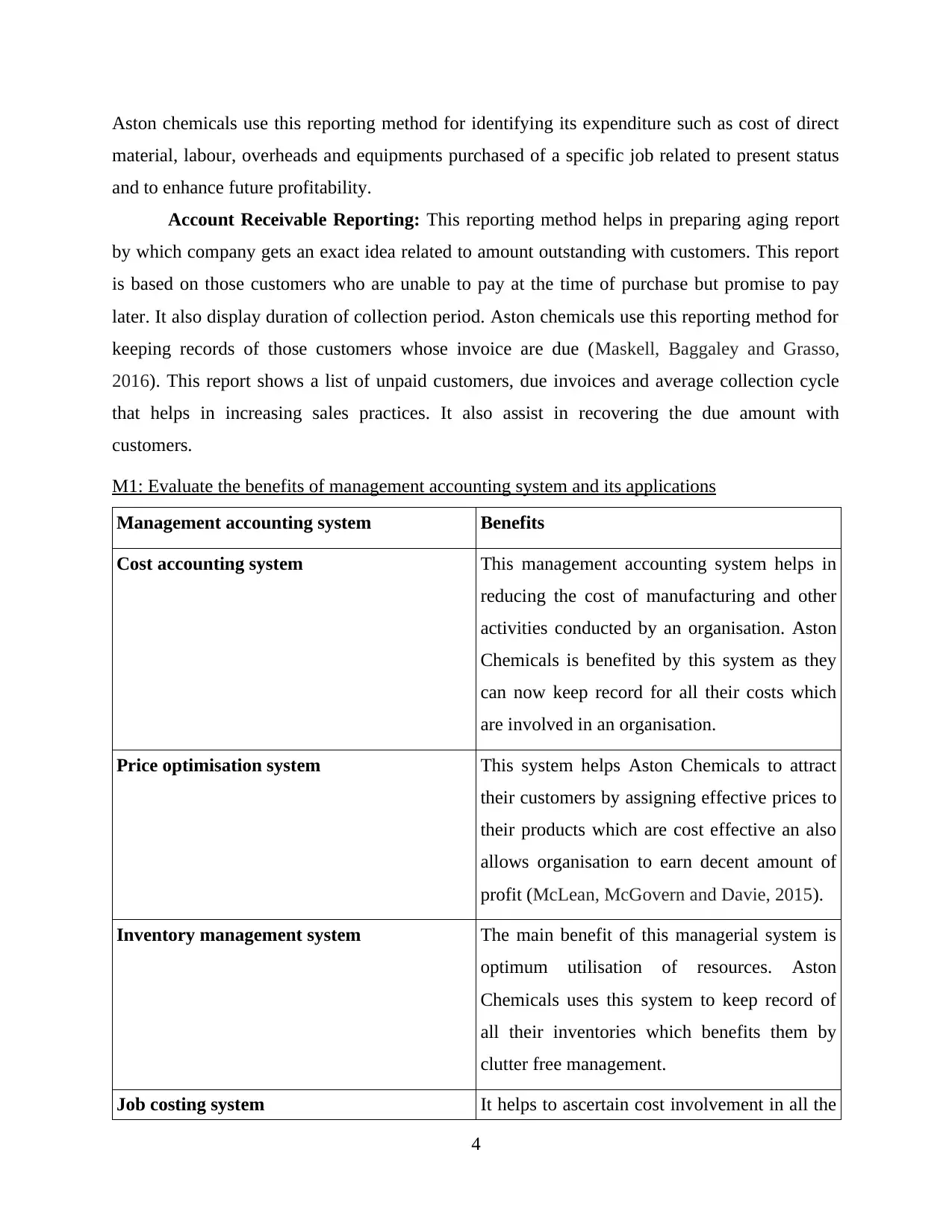
Aston chemicals use this reporting method for identifying its expenditure such as cost of direct
material, labour, overheads and equipments purchased of a specific job related to present status
and to enhance future profitability.
Account Receivable Reporting: This reporting method helps in preparing aging report
by which company gets an exact idea related to amount outstanding with customers. This report
is based on those customers who are unable to pay at the time of purchase but promise to pay
later. It also display duration of collection period. Aston chemicals use this reporting method for
keeping records of those customers whose invoice are due (Maskell, Baggaley and Grasso,
2016). This report shows a list of unpaid customers, due invoices and average collection cycle
that helps in increasing sales practices. It also assist in recovering the due amount with
customers.
M1: Evaluate the benefits of management accounting system and its applications
Management accounting system Benefits
Cost accounting system This management accounting system helps in
reducing the cost of manufacturing and other
activities conducted by an organisation. Aston
Chemicals is benefited by this system as they
can now keep record for all their costs which
are involved in an organisation.
Price optimisation system This system helps Aston Chemicals to attract
their customers by assigning effective prices to
their products which are cost effective an also
allows organisation to earn decent amount of
profit (McLean, McGovern and Davie, 2015).
Inventory management system The main benefit of this managerial system is
optimum utilisation of resources. Aston
Chemicals uses this system to keep record of
all their inventories which benefits them by
clutter free management.
Job costing system It helps to ascertain cost involvement in all the
4
material, labour, overheads and equipments purchased of a specific job related to present status
and to enhance future profitability.
Account Receivable Reporting: This reporting method helps in preparing aging report
by which company gets an exact idea related to amount outstanding with customers. This report
is based on those customers who are unable to pay at the time of purchase but promise to pay
later. It also display duration of collection period. Aston chemicals use this reporting method for
keeping records of those customers whose invoice are due (Maskell, Baggaley and Grasso,
2016). This report shows a list of unpaid customers, due invoices and average collection cycle
that helps in increasing sales practices. It also assist in recovering the due amount with
customers.
M1: Evaluate the benefits of management accounting system and its applications
Management accounting system Benefits
Cost accounting system This management accounting system helps in
reducing the cost of manufacturing and other
activities conducted by an organisation. Aston
Chemicals is benefited by this system as they
can now keep record for all their costs which
are involved in an organisation.
Price optimisation system This system helps Aston Chemicals to attract
their customers by assigning effective prices to
their products which are cost effective an also
allows organisation to earn decent amount of
profit (McLean, McGovern and Davie, 2015).
Inventory management system The main benefit of this managerial system is
optimum utilisation of resources. Aston
Chemicals uses this system to keep record of
all their inventories which benefits them by
clutter free management.
Job costing system It helps to ascertain cost involvement in all the
4
⊘ This is a preview!⊘
Do you want full access?
Subscribe today to unlock all pages.

Trusted by 1+ million students worldwide
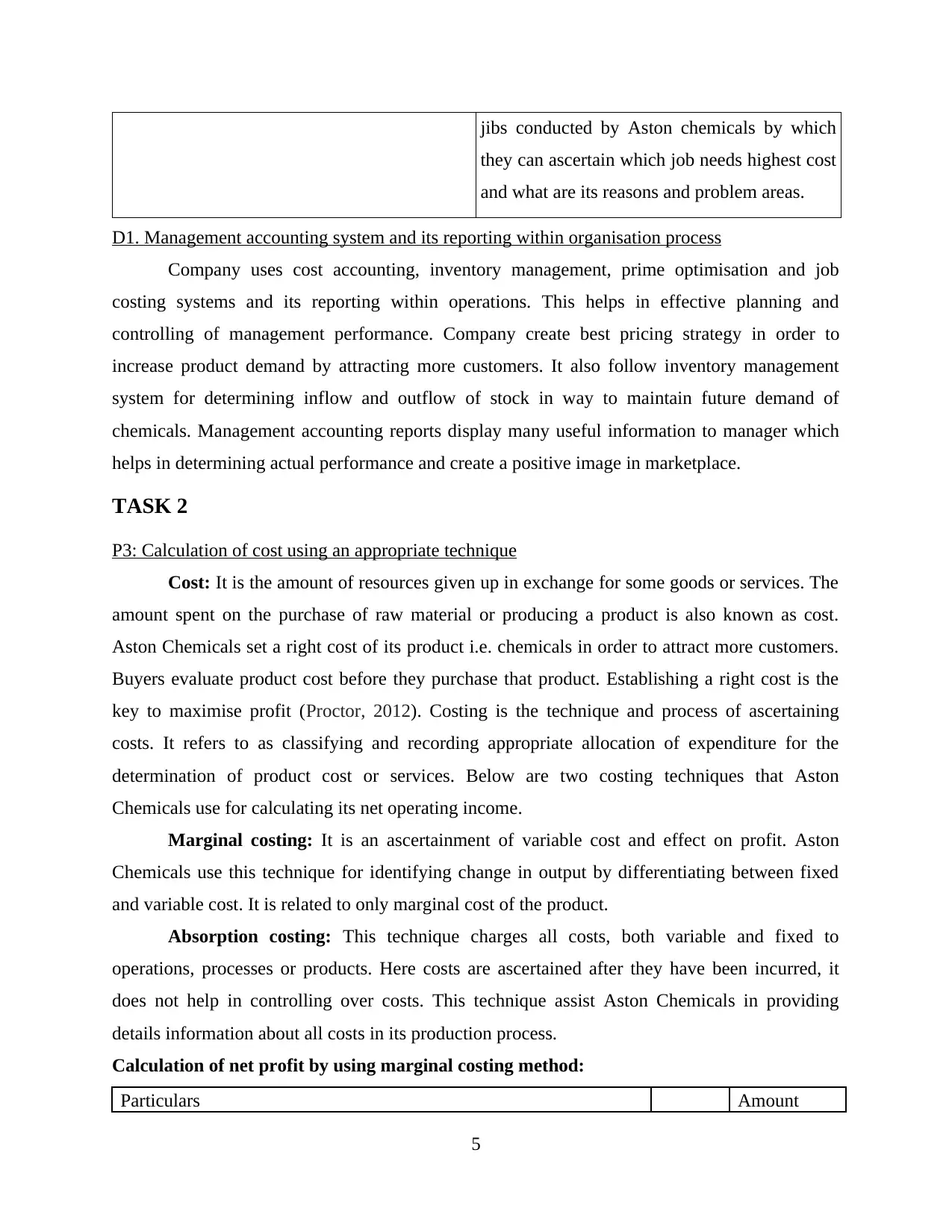
jibs conducted by Aston chemicals by which
they can ascertain which job needs highest cost
and what are its reasons and problem areas.
D1. Management accounting system and its reporting within organisation process
Company uses cost accounting, inventory management, prime optimisation and job
costing systems and its reporting within operations. This helps in effective planning and
controlling of management performance. Company create best pricing strategy in order to
increase product demand by attracting more customers. It also follow inventory management
system for determining inflow and outflow of stock in way to maintain future demand of
chemicals. Management accounting reports display many useful information to manager which
helps in determining actual performance and create a positive image in marketplace.
TASK 2
P3: Calculation of cost using an appropriate technique
Cost: It is the amount of resources given up in exchange for some goods or services. The
amount spent on the purchase of raw material or producing a product is also known as cost.
Aston Chemicals set a right cost of its product i.e. chemicals in order to attract more customers.
Buyers evaluate product cost before they purchase that product. Establishing a right cost is the
key to maximise profit (Proctor, 2012). Costing is the technique and process of ascertaining
costs. It refers to as classifying and recording appropriate allocation of expenditure for the
determination of product cost or services. Below are two costing techniques that Aston
Chemicals use for calculating its net operating income.
Marginal costing: It is an ascertainment of variable cost and effect on profit. Aston
Chemicals use this technique for identifying change in output by differentiating between fixed
and variable cost. It is related to only marginal cost of the product.
Absorption costing: This technique charges all costs, both variable and fixed to
operations, processes or products. Here costs are ascertained after they have been incurred, it
does not help in controlling over costs. This technique assist Aston Chemicals in providing
details information about all costs in its production process.
Calculation of net profit by using marginal costing method:
Particulars Amount
5
they can ascertain which job needs highest cost
and what are its reasons and problem areas.
D1. Management accounting system and its reporting within organisation process
Company uses cost accounting, inventory management, prime optimisation and job
costing systems and its reporting within operations. This helps in effective planning and
controlling of management performance. Company create best pricing strategy in order to
increase product demand by attracting more customers. It also follow inventory management
system for determining inflow and outflow of stock in way to maintain future demand of
chemicals. Management accounting reports display many useful information to manager which
helps in determining actual performance and create a positive image in marketplace.
TASK 2
P3: Calculation of cost using an appropriate technique
Cost: It is the amount of resources given up in exchange for some goods or services. The
amount spent on the purchase of raw material or producing a product is also known as cost.
Aston Chemicals set a right cost of its product i.e. chemicals in order to attract more customers.
Buyers evaluate product cost before they purchase that product. Establishing a right cost is the
key to maximise profit (Proctor, 2012). Costing is the technique and process of ascertaining
costs. It refers to as classifying and recording appropriate allocation of expenditure for the
determination of product cost or services. Below are two costing techniques that Aston
Chemicals use for calculating its net operating income.
Marginal costing: It is an ascertainment of variable cost and effect on profit. Aston
Chemicals use this technique for identifying change in output by differentiating between fixed
and variable cost. It is related to only marginal cost of the product.
Absorption costing: This technique charges all costs, both variable and fixed to
operations, processes or products. Here costs are ascertained after they have been incurred, it
does not help in controlling over costs. This technique assist Aston Chemicals in providing
details information about all costs in its production process.
Calculation of net profit by using marginal costing method:
Particulars Amount
5
Paraphrase This Document
Need a fresh take? Get an instant paraphrase of this document with our AI Paraphraser
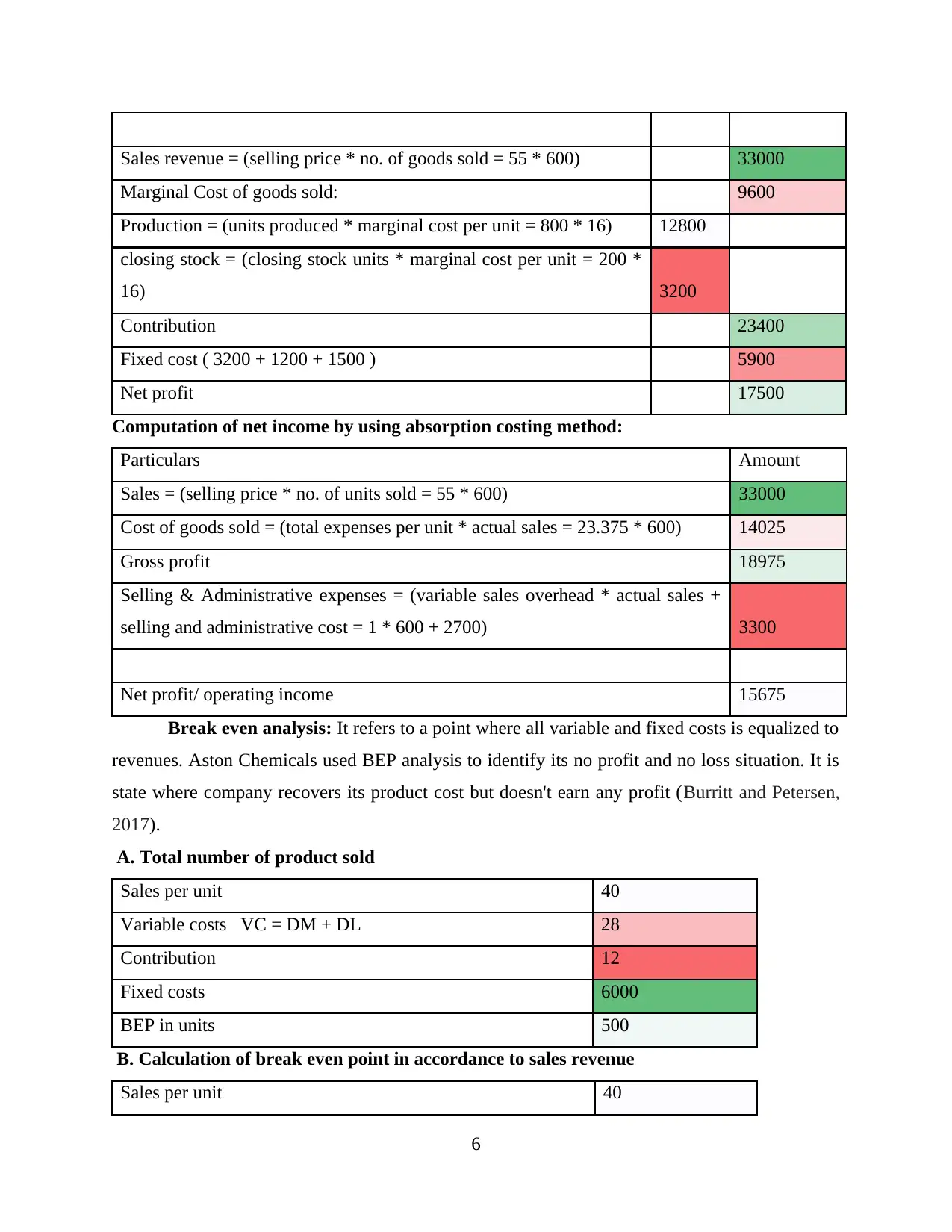
Sales revenue = (selling price * no. of goods sold = 55 * 600) 33000
Marginal Cost of goods sold: 9600
Production = (units produced * marginal cost per unit = 800 * 16) 12800
closing stock = (closing stock units * marginal cost per unit = 200 *
16) 3200
Contribution 23400
Fixed cost ( 3200 + 1200 + 1500 ) 5900
Net profit 17500
Computation of net income by using absorption costing method:
Particulars Amount
Sales = (selling price * no. of units sold = 55 * 600) 33000
Cost of goods sold = (total expenses per unit * actual sales = 23.375 * 600) 14025
Gross profit 18975
Selling & Administrative expenses = (variable sales overhead * actual sales +
selling and administrative cost = 1 * 600 + 2700) 3300
Net profit/ operating income 15675
Break even analysis: It refers to a point where all variable and fixed costs is equalized to
revenues. Aston Chemicals used BEP analysis to identify its no profit and no loss situation. It is
state where company recovers its product cost but doesn't earn any profit (Burritt and Petersen,
2017).
A. Total number of product sold
Sales per unit 40
Variable costs VC = DM + DL 28
Contribution 12
Fixed costs 6000
BEP in units 500
B. Calculation of break even point in accordance to sales revenue
Sales per unit 40
6
Marginal Cost of goods sold: 9600
Production = (units produced * marginal cost per unit = 800 * 16) 12800
closing stock = (closing stock units * marginal cost per unit = 200 *
16) 3200
Contribution 23400
Fixed cost ( 3200 + 1200 + 1500 ) 5900
Net profit 17500
Computation of net income by using absorption costing method:
Particulars Amount
Sales = (selling price * no. of units sold = 55 * 600) 33000
Cost of goods sold = (total expenses per unit * actual sales = 23.375 * 600) 14025
Gross profit 18975
Selling & Administrative expenses = (variable sales overhead * actual sales +
selling and administrative cost = 1 * 600 + 2700) 3300
Net profit/ operating income 15675
Break even analysis: It refers to a point where all variable and fixed costs is equalized to
revenues. Aston Chemicals used BEP analysis to identify its no profit and no loss situation. It is
state where company recovers its product cost but doesn't earn any profit (Burritt and Petersen,
2017).
A. Total number of product sold
Sales per unit 40
Variable costs VC = DM + DL 28
Contribution 12
Fixed costs 6000
BEP in units 500
B. Calculation of break even point in accordance to sales revenue
Sales per unit 40
6
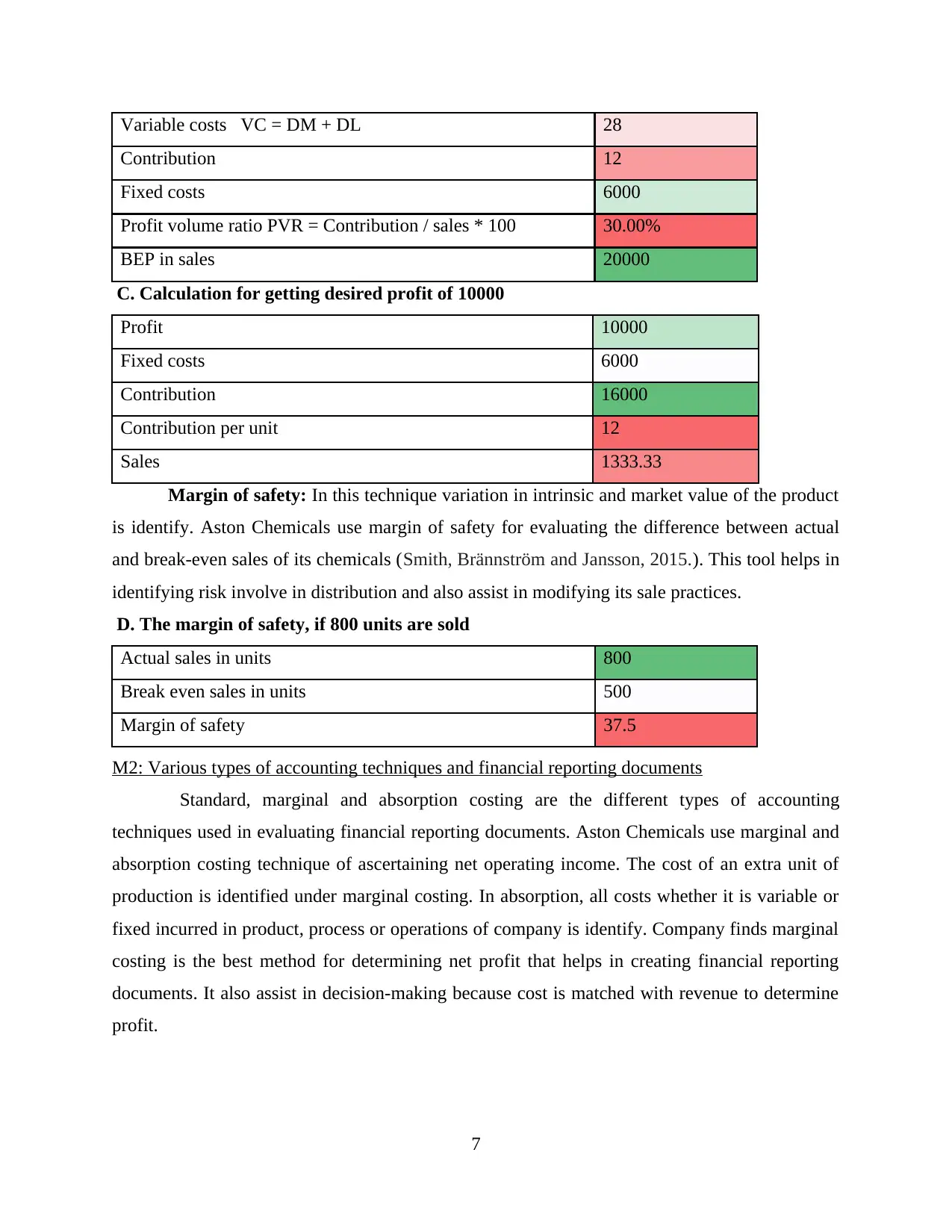
Variable costs VC = DM + DL 28
Contribution 12
Fixed costs 6000
Profit volume ratio PVR = Contribution / sales * 100 30.00%
BEP in sales 20000
C. Calculation for getting desired profit of 10000
Profit 10000
Fixed costs 6000
Contribution 16000
Contribution per unit 12
Sales 1333.33
Margin of safety: In this technique variation in intrinsic and market value of the product
is identify. Aston Chemicals use margin of safety for evaluating the difference between actual
and break-even sales of its chemicals (Smith, Brännström and Jansson, 2015.). This tool helps in
identifying risk involve in distribution and also assist in modifying its sale practices.
D. The margin of safety, if 800 units are sold
Actual sales in units 800
Break even sales in units 500
Margin of safety 37.5
M2: Various types of accounting techniques and financial reporting documents
Standard, marginal and absorption costing are the different types of accounting
techniques used in evaluating financial reporting documents. Aston Chemicals use marginal and
absorption costing technique of ascertaining net operating income. The cost of an extra unit of
production is identified under marginal costing. In absorption, all costs whether it is variable or
fixed incurred in product, process or operations of company is identify. Company finds marginal
costing is the best method for determining net profit that helps in creating financial reporting
documents. It also assist in decision-making because cost is matched with revenue to determine
profit.
7
Contribution 12
Fixed costs 6000
Profit volume ratio PVR = Contribution / sales * 100 30.00%
BEP in sales 20000
C. Calculation for getting desired profit of 10000
Profit 10000
Fixed costs 6000
Contribution 16000
Contribution per unit 12
Sales 1333.33
Margin of safety: In this technique variation in intrinsic and market value of the product
is identify. Aston Chemicals use margin of safety for evaluating the difference between actual
and break-even sales of its chemicals (Smith, Brännström and Jansson, 2015.). This tool helps in
identifying risk involve in distribution and also assist in modifying its sale practices.
D. The margin of safety, if 800 units are sold
Actual sales in units 800
Break even sales in units 500
Margin of safety 37.5
M2: Various types of accounting techniques and financial reporting documents
Standard, marginal and absorption costing are the different types of accounting
techniques used in evaluating financial reporting documents. Aston Chemicals use marginal and
absorption costing technique of ascertaining net operating income. The cost of an extra unit of
production is identified under marginal costing. In absorption, all costs whether it is variable or
fixed incurred in product, process or operations of company is identify. Company finds marginal
costing is the best method for determining net profit that helps in creating financial reporting
documents. It also assist in decision-making because cost is matched with revenue to determine
profit.
7
⊘ This is a preview!⊘
Do you want full access?
Subscribe today to unlock all pages.

Trusted by 1+ million students worldwide
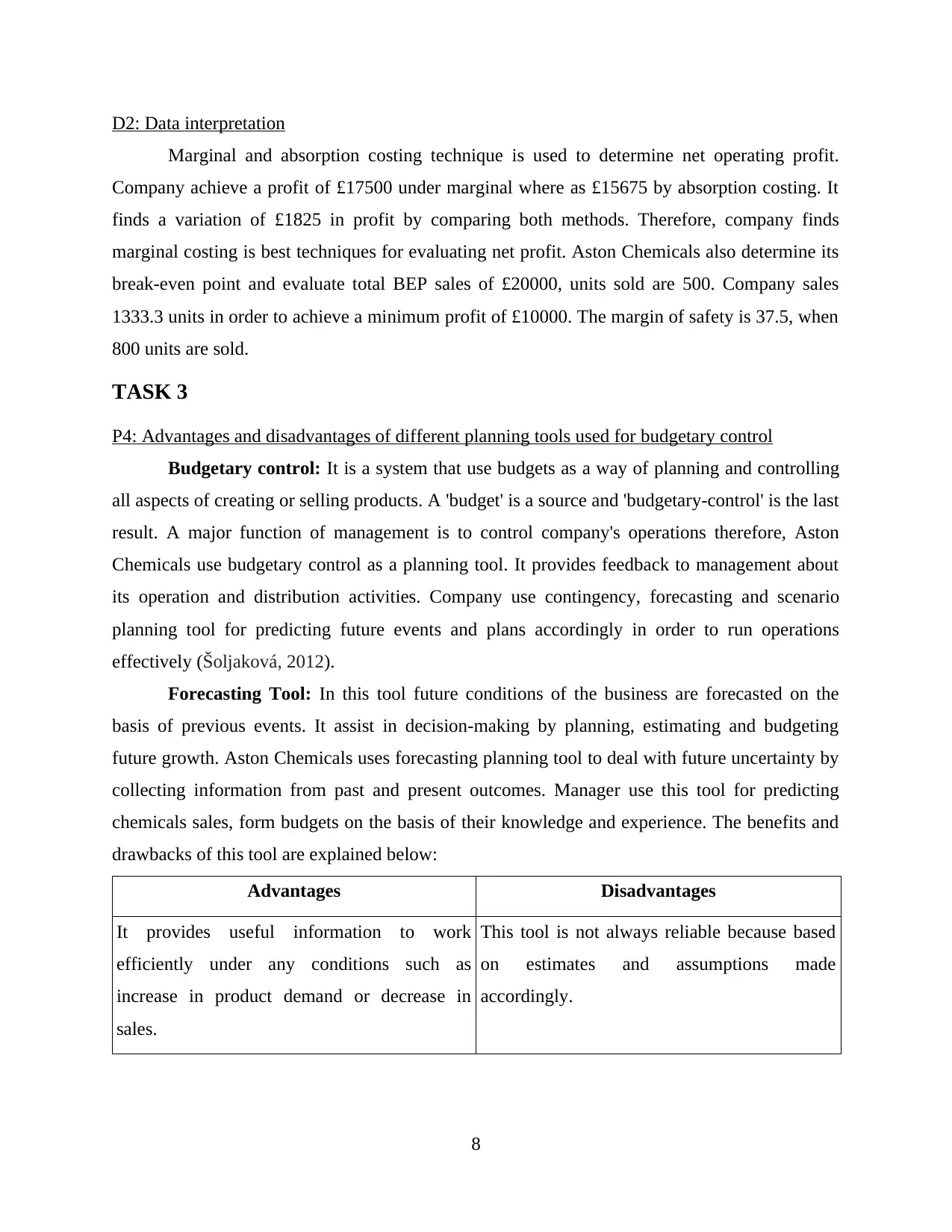
D2: Data interpretation
Marginal and absorption costing technique is used to determine net operating profit.
Company achieve a profit of £17500 under marginal where as £15675 by absorption costing. It
finds a variation of £1825 in profit by comparing both methods. Therefore, company finds
marginal costing is best techniques for evaluating net profit. Aston Chemicals also determine its
break-even point and evaluate total BEP sales of £20000, units sold are 500. Company sales
1333.3 units in order to achieve a minimum profit of £10000. The margin of safety is 37.5, when
800 units are sold.
TASK 3
P4: Advantages and disadvantages of different planning tools used for budgetary control
Budgetary control: It is a system that use budgets as a way of planning and controlling
all aspects of creating or selling products. A 'budget' is a source and 'budgetary-control' is the last
result. A major function of management is to control company's operations therefore, Aston
Chemicals use budgetary control as a planning tool. It provides feedback to management about
its operation and distribution activities. Company use contingency, forecasting and scenario
planning tool for predicting future events and plans accordingly in order to run operations
effectively (Šoljaková, 2012).
Forecasting Tool: In this tool future conditions of the business are forecasted on the
basis of previous events. It assist in decision-making by planning, estimating and budgeting
future growth. Aston Chemicals uses forecasting planning tool to deal with future uncertainty by
collecting information from past and present outcomes. Manager use this tool for predicting
chemicals sales, form budgets on the basis of their knowledge and experience. The benefits and
drawbacks of this tool are explained below:
Advantages Disadvantages
It provides useful information to work
efficiently under any conditions such as
increase in product demand or decrease in
sales.
This tool is not always reliable because based
on estimates and assumptions made
accordingly.
8
Marginal and absorption costing technique is used to determine net operating profit.
Company achieve a profit of £17500 under marginal where as £15675 by absorption costing. It
finds a variation of £1825 in profit by comparing both methods. Therefore, company finds
marginal costing is best techniques for evaluating net profit. Aston Chemicals also determine its
break-even point and evaluate total BEP sales of £20000, units sold are 500. Company sales
1333.3 units in order to achieve a minimum profit of £10000. The margin of safety is 37.5, when
800 units are sold.
TASK 3
P4: Advantages and disadvantages of different planning tools used for budgetary control
Budgetary control: It is a system that use budgets as a way of planning and controlling
all aspects of creating or selling products. A 'budget' is a source and 'budgetary-control' is the last
result. A major function of management is to control company's operations therefore, Aston
Chemicals use budgetary control as a planning tool. It provides feedback to management about
its operation and distribution activities. Company use contingency, forecasting and scenario
planning tool for predicting future events and plans accordingly in order to run operations
effectively (Šoljaková, 2012).
Forecasting Tool: In this tool future conditions of the business are forecasted on the
basis of previous events. It assist in decision-making by planning, estimating and budgeting
future growth. Aston Chemicals uses forecasting planning tool to deal with future uncertainty by
collecting information from past and present outcomes. Manager use this tool for predicting
chemicals sales, form budgets on the basis of their knowledge and experience. The benefits and
drawbacks of this tool are explained below:
Advantages Disadvantages
It provides useful information to work
efficiently under any conditions such as
increase in product demand or decrease in
sales.
This tool is not always reliable because based
on estimates and assumptions made
accordingly.
8
Paraphrase This Document
Need a fresh take? Get an instant paraphrase of this document with our AI Paraphraser
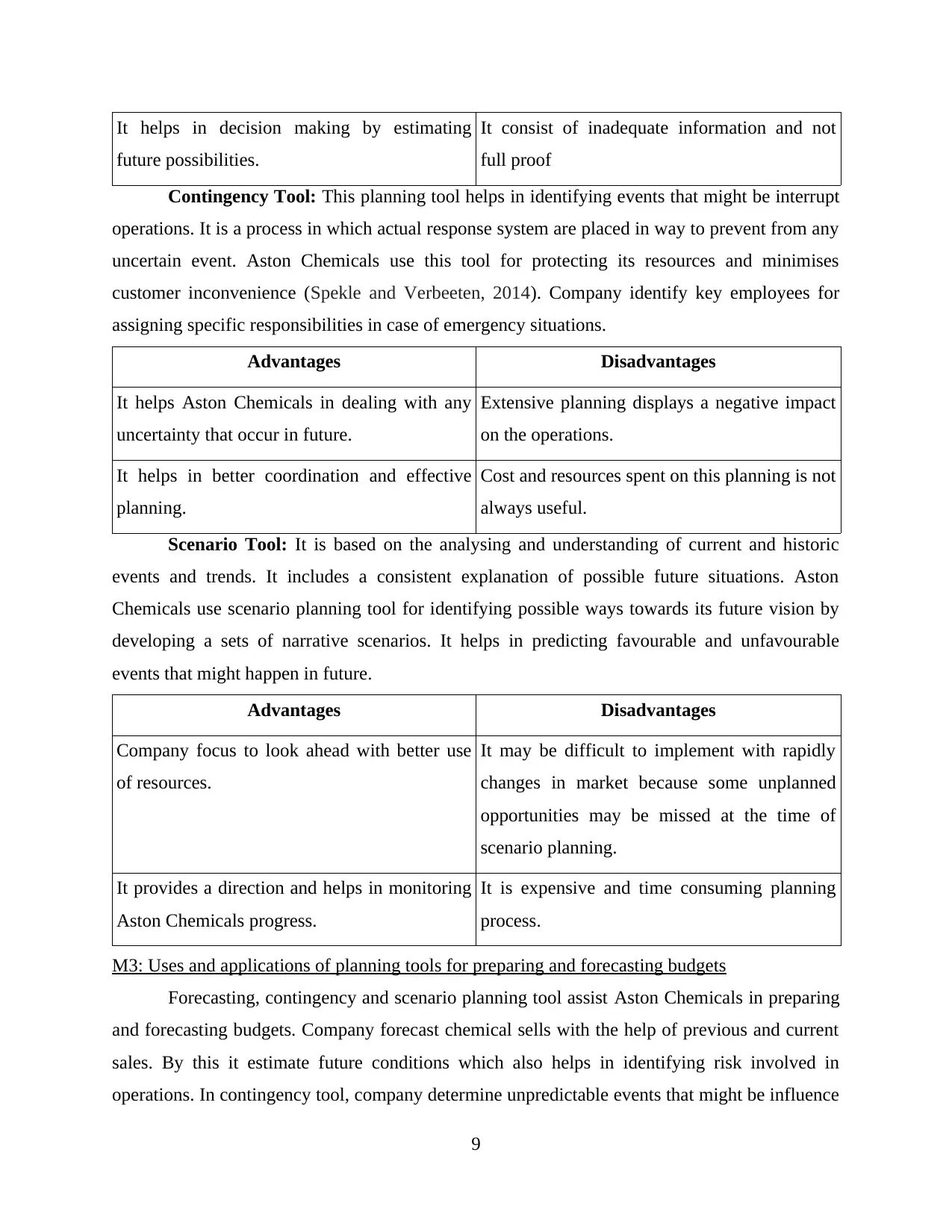
It helps in decision making by estimating
future possibilities.
It consist of inadequate information and not
full proof
Contingency Tool: This planning tool helps in identifying events that might be interrupt
operations. It is a process in which actual response system are placed in way to prevent from any
uncertain event. Aston Chemicals use this tool for protecting its resources and minimises
customer inconvenience (Spekle and Verbeeten, 2014). Company identify key employees for
assigning specific responsibilities in case of emergency situations.
Advantages Disadvantages
It helps Aston Chemicals in dealing with any
uncertainty that occur in future.
Extensive planning displays a negative impact
on the operations.
It helps in better coordination and effective
planning.
Cost and resources spent on this planning is not
always useful.
Scenario Tool: It is based on the analysing and understanding of current and historic
events and trends. It includes a consistent explanation of possible future situations. Aston
Chemicals use scenario planning tool for identifying possible ways towards its future vision by
developing a sets of narrative scenarios. It helps in predicting favourable and unfavourable
events that might happen in future.
Advantages Disadvantages
Company focus to look ahead with better use
of resources.
It may be difficult to implement with rapidly
changes in market because some unplanned
opportunities may be missed at the time of
scenario planning.
It provides a direction and helps in monitoring
Aston Chemicals progress.
It is expensive and time consuming planning
process.
M3: Uses and applications of planning tools for preparing and forecasting budgets
Forecasting, contingency and scenario planning tool assist Aston Chemicals in preparing
and forecasting budgets. Company forecast chemical sells with the help of previous and current
sales. By this it estimate future conditions which also helps in identifying risk involved in
operations. In contingency tool, company determine unpredictable events that might be influence
9
future possibilities.
It consist of inadequate information and not
full proof
Contingency Tool: This planning tool helps in identifying events that might be interrupt
operations. It is a process in which actual response system are placed in way to prevent from any
uncertain event. Aston Chemicals use this tool for protecting its resources and minimises
customer inconvenience (Spekle and Verbeeten, 2014). Company identify key employees for
assigning specific responsibilities in case of emergency situations.
Advantages Disadvantages
It helps Aston Chemicals in dealing with any
uncertainty that occur in future.
Extensive planning displays a negative impact
on the operations.
It helps in better coordination and effective
planning.
Cost and resources spent on this planning is not
always useful.
Scenario Tool: It is based on the analysing and understanding of current and historic
events and trends. It includes a consistent explanation of possible future situations. Aston
Chemicals use scenario planning tool for identifying possible ways towards its future vision by
developing a sets of narrative scenarios. It helps in predicting favourable and unfavourable
events that might happen in future.
Advantages Disadvantages
Company focus to look ahead with better use
of resources.
It may be difficult to implement with rapidly
changes in market because some unplanned
opportunities may be missed at the time of
scenario planning.
It provides a direction and helps in monitoring
Aston Chemicals progress.
It is expensive and time consuming planning
process.
M3: Uses and applications of planning tools for preparing and forecasting budgets
Forecasting, contingency and scenario planning tool assist Aston Chemicals in preparing
and forecasting budgets. Company forecast chemical sells with the help of previous and current
sales. By this it estimate future conditions which also helps in identifying risk involved in
operations. In contingency tool, company determine unpredictable events that might be influence
9
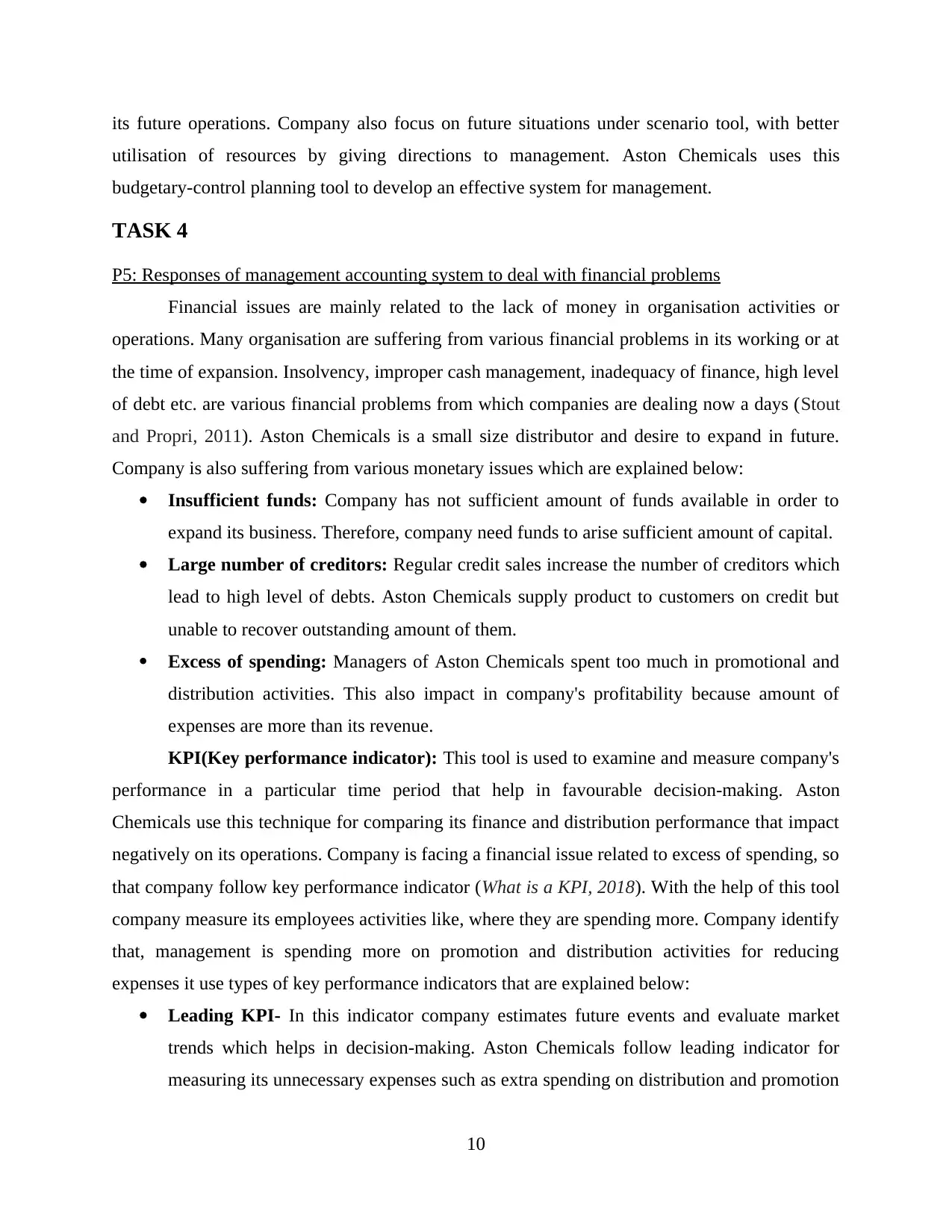
its future operations. Company also focus on future situations under scenario tool, with better
utilisation of resources by giving directions to management. Aston Chemicals uses this
budgetary-control planning tool to develop an effective system for management.
TASK 4
P5: Responses of management accounting system to deal with financial problems
Financial issues are mainly related to the lack of money in organisation activities or
operations. Many organisation are suffering from various financial problems in its working or at
the time of expansion. Insolvency, improper cash management, inadequacy of finance, high level
of debt etc. are various financial problems from which companies are dealing now a days (Stout
and Propri, 2011). Aston Chemicals is a small size distributor and desire to expand in future.
Company is also suffering from various monetary issues which are explained below:
Insufficient funds: Company has not sufficient amount of funds available in order to
expand its business. Therefore, company need funds to arise sufficient amount of capital.
Large number of creditors: Regular credit sales increase the number of creditors which
lead to high level of debts. Aston Chemicals supply product to customers on credit but
unable to recover outstanding amount of them.
Excess of spending: Managers of Aston Chemicals spent too much in promotional and
distribution activities. This also impact in company's profitability because amount of
expenses are more than its revenue.
KPI(Key performance indicator): This tool is used to examine and measure company's
performance in a particular time period that help in favourable decision-making. Aston
Chemicals use this technique for comparing its finance and distribution performance that impact
negatively on its operations. Company is facing a financial issue related to excess of spending, so
that company follow key performance indicator (What is a KPI, 2018). With the help of this tool
company measure its employees activities like, where they are spending more. Company identify
that, management is spending more on promotion and distribution activities for reducing
expenses it use types of key performance indicators that are explained below:
Leading KPI- In this indicator company estimates future events and evaluate market
trends which helps in decision-making. Aston Chemicals follow leading indicator for
measuring its unnecessary expenses such as extra spending on distribution and promotion
10
utilisation of resources by giving directions to management. Aston Chemicals uses this
budgetary-control planning tool to develop an effective system for management.
TASK 4
P5: Responses of management accounting system to deal with financial problems
Financial issues are mainly related to the lack of money in organisation activities or
operations. Many organisation are suffering from various financial problems in its working or at
the time of expansion. Insolvency, improper cash management, inadequacy of finance, high level
of debt etc. are various financial problems from which companies are dealing now a days (Stout
and Propri, 2011). Aston Chemicals is a small size distributor and desire to expand in future.
Company is also suffering from various monetary issues which are explained below:
Insufficient funds: Company has not sufficient amount of funds available in order to
expand its business. Therefore, company need funds to arise sufficient amount of capital.
Large number of creditors: Regular credit sales increase the number of creditors which
lead to high level of debts. Aston Chemicals supply product to customers on credit but
unable to recover outstanding amount of them.
Excess of spending: Managers of Aston Chemicals spent too much in promotional and
distribution activities. This also impact in company's profitability because amount of
expenses are more than its revenue.
KPI(Key performance indicator): This tool is used to examine and measure company's
performance in a particular time period that help in favourable decision-making. Aston
Chemicals use this technique for comparing its finance and distribution performance that impact
negatively on its operations. Company is facing a financial issue related to excess of spending, so
that company follow key performance indicator (What is a KPI, 2018). With the help of this tool
company measure its employees activities like, where they are spending more. Company identify
that, management is spending more on promotion and distribution activities for reducing
expenses it use types of key performance indicators that are explained below:
Leading KPI- In this indicator company estimates future events and evaluate market
trends which helps in decision-making. Aston Chemicals follow leading indicator for
measuring its unnecessary expenses such as extra spending on distribution and promotion
10
⊘ This is a preview!⊘
Do you want full access?
Subscribe today to unlock all pages.

Trusted by 1+ million students worldwide
1 out of 15
Related Documents
Your All-in-One AI-Powered Toolkit for Academic Success.
+13062052269
info@desklib.com
Available 24*7 on WhatsApp / Email
![[object Object]](/_next/static/media/star-bottom.7253800d.svg)
Unlock your academic potential
Copyright © 2020–2025 A2Z Services. All Rights Reserved. Developed and managed by ZUCOL.





